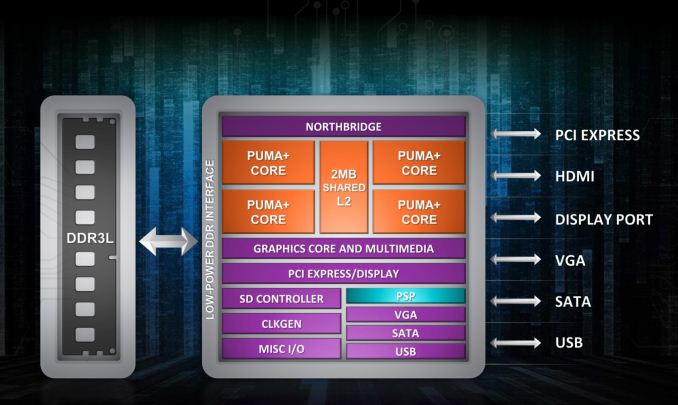AMD Beema/Mullins Architecture & Performance Preview
by Anand Lal Shimpi on April 29, 2014 12:00 AM ESTFinal Words
Despite no significant changes to the architecture or manufacturing process, AMD’s 2014 updates to its entry level and low power silicon are substantial. We finally have AMD silicon, built around a non-Bulldozer architecture, that seem to have turbo capabilities comparable to Intel’s. The result is a completely different performance profile. While AMD’s Jaguar cores in Kabini and Temash were easily outperformed by Intel’s Bay Trail, Puma+ pulls ahead. AMD continues to hold a substantial GPU performance advantage as well.
The gains in performance come while decreasing platform power. You can now have roughly the same performance as AMD offered last year in a 15W entry level notebook part, in a 4.5W TDP (2.8W SDP) tablet SKU. That’s seriously impressive.
The progress AMD made in a year with Beema and Mullins shows just how time constrained the team(s) were with bringing Kabini and Temash to market in 2013. While both of those SoCs were quite successful for AMD, I expect that at some point AMD won’t be allowed two years to fully polish a single design.
The big unknown is how these new SoCs stack up against Bay Trail when it comes to power consumption. From a performance standpoint at the very high end they are faster, but we’ll have to wait until we can get our hands on shipping devices before we know the full story when it comes to battery life. AMD expects to see Beema and Mullins designs show up over the next 1 - 2 quarters, with some designs shipping in the coming weeks to specific regions.
The other thing we need to see is a real Android strategy from AMD. Mullins seems like a good fit for a high performance Android tablet, but today AMD’s native OS strategy is exclusively Windows. I don’t think it’ll stay that way for long, but AMD has yet to give us any indication of when it’ll change.
And if I’m asking for things I want to see from AMD, you can add a PoP package and idle power that’s competitive with the likes of Apple and Qualcomm. AMD clearly came a long way over the past couple of years, but there’s still more progress to be made.











82 Comments
View All Comments
vlad42 - Tuesday, April 29, 2014 - link
Hey Anand,Do you know if connected standby was enabled on the Mullins tablet you tested? I’ve heard that AMD has not yet developed the connected standby drivers yet. If this is the case, then shouldn’t that be noted in the power consumption test? Given the improvements Intel sees when connected standby is enabled, it definitely looks like the Mullins tablet was not using connected standby.
Anand Lal Shimpi - Tuesday, April 29, 2014 - link
No CS, although I believe Mullins could theoretically support it. For this particular test there should be no advantage to having CS, we're just looking at short/active idle power usage.Anand Lal Shimpi - Tuesday, April 29, 2014 - link
Correction - there are no plans to support CS, AMD doesn't see value in it.tomsworkshop - Tuesday, April 29, 2014 - link
this low power but high performance tiny little chip can be fit on something like the raspberry pi, we can build a really small micro pc with such hardware.mfoley93 - Wednesday, April 30, 2014 - link
They aren't low power enough yet, so in the mean time, I suspect nVIDIA's Jetson board based off the Tegra K1 might fit the spot you are thinking of. The board is significantly larger, but its powerful enought to justify that. It's also more in the Beagleboard/Pandaboard segment, being aimed at embedded development and not education.http://www.nvidia.com/object/jetson-tk1-embedded-d...
tomsworkshop - Thursday, May 1, 2014 - link
The Tegra K1 rated at 5W TDP, the Mullins rated at 3.95W - 4.5W TDP, i think they should be low power enough for a single board computer, i saw the price for the Jetson TK1, it was 3 times higher than the Raspberry Pi, hope that AMD will come out something at the middle of the Raspberry Pi and Jetson TK1, with the price lower than the Jetson TK1, and the performance better than the Raspberry Pi.nemi2 - Tuesday, April 29, 2014 - link
It's good to see AMD catching up but the power consumption may still be a deciding factor when choosing between this and Baytrail - I look forward to a full review of release hardware. The other area of concern is that the Baytrail successor Airmont (with shrink to 14nm and ~30% power savings) will also be out in 2014 so AMD may only have 0-3 months at parity/competitiveness with intel.H2323 - Tuesday, April 29, 2014 - link
Yes these are shorty terms wins, but 14nm airmont is late and will miss back to school and be just in time for christmas, AMD will net some revenue on this and still retain GPU lead with baytrailR3MF - Tuesday, April 29, 2014 - link
a four-core mullins in an 8" tablet chassis with 4GB of memory and bios support for a 64bit ubuntu would be an awesome thing.MrSpadge - Tuesday, April 29, 2014 - link
I'd rather have a Thinkpad 10 + Win 8.1 with this, at least as an option instead of Bay Trail. If the actual product is as impressive as the preview.